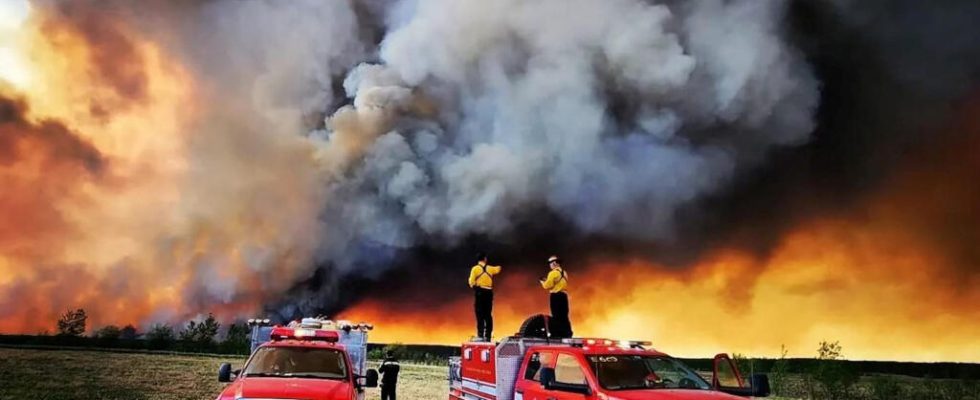The fires that are ravaging Canada from coast to coast are emitting a lot of carbon into the atmosphere, at the risk of permanently weighing down the country in its fight against climate change. Some researchers suggest taking advantage of this disastrous window of opportunity to better adapt Canadian forests to future disruptions.
5 mins
from our correspondent in Quebec,
The figure was in all the international media at the end of July: fires in canada emitted more than 290 megatons of CO2 into the atmosphere. That’s double the previous record from 2014. Now more than 130,000 square kilometers have been burned, making this year Canada’s worst year ever, and an area six times the decade average. past.
Necessarily, Canadian researchers are alarmed. For Catherine Potvin, forest biologist interviewed in The duty, it is a toggle. ” The decline of the forests, we predicted it, and we said: be careful, when the forests start to decline, we lose control. And there, now, it’s obvious that it’s happening “, she recalls in the article from the Quebec daily.
Evelyne Thiffault, a researcher specializing in the study of forest carbon at Laval University, agrees: the disaster is here and this exceptional year will eventually become the norm. ” The El Niño phenomenon has accentuated forest fires in Canada this year, next year could be calmer, but it gives an idea of what the near future will be: more frequent, more intense fires, and carbon emissions records “, explains the professor at Radio France Internationale.
A valuable ecosystem
To fully understand the magnitude of the situation, one must understand the role played by thea boreal forest, the fire-affected ecosystem in Canada, in carbon sequestration. Current climate change is caused by the emission of greenhouse gases, including CO2. This carbon can be emitted during the combustion of fossil fuels such as oil, for example, or retained, thanks to photosynthesis in particular, in the ocean or forests.
However, the boreal forest is originally a carbon sink, ie it retains more carbon than it emits. ” For millennia, the boreal forest has had time to accumulate a lot of carbon, particularly in the soil, because the low temperatures in its geographical area slow down decomposition and increase the amount of carbon stored: it is a very large reservoir. confirms Évelyne Thiffault.
The problem is that the boreal forest has become more of a carbon emitter than a carbon holder: this is the consequence of various disasters that have occurred in Canada in recent years. The root of these disasters is rising temperatures. It accelerates decomposition, micro-organisms will therefore consume more wood and release more carbon, forests will burn more, from the ground to the canopy and insect epidemics will increase, recalls the researcher: ” Western Canada has experienced a fairly severe epidemic of pine beetle, which killed a large part of the trees. It is therefore dead wood which decomposes, and which emits additional carbon into the atmosphere. “.
An officially spared carbon footprint
Politicians need not worry. Canada’s carbon footprint, which must drop sharply if the country is to meet the Paris Agreements, does not include carbon emissions from “natural” sources. This applies to both fires and volcanic eruptions. A country will therefore never have to answer for the emissions of a forest fire, regardless of whether the fires are accentuated by climate change, whether the country invests enough or not in its emergency services, or whether poor management of forests has multiplied fire risks.
Still, this forest carbon goes into the atmosphere, and it contributes to climate change. If taken into account, the carbon footprint of the fires would be an impossible burden for Canada. Despite everything, there’s no question of giving up, insists Évelyne Thiffault: “ Above all, we must not throw in the towel, on the contrary: to compensate for this carbon which naturally leaves in the atmosphere, we must even more reduce the sources of carbon coming from human sources. “.
Adapt the forest
In addition to reducing our anthropogenic emissions, there are solutions to reduce the release of carbon from forests. Man must do what he knows how to do best: modify his environment, but this time virtuously. ” The idea is to help the forest adapt by doing assisted migration, because forest ecosystems cannot adapt so quickly. We could therefore plant species that are more resistant to fires, such as hardwoods “, explains the researcher. This solution is far from being a solution without sacrifices: we would lose precious tree species, as well as all the animal and plant species they shelter, but we would limit the risk of fires and climate runaway.
For the moment, a few local initiatives are at work in Canada: they are mainly experimental. The federal government has promised to plant two billion trees by 2030, but these essences will have to be intelligently thought out, warns the professor. In any case, the ecosystem that will take the place of the boreal forest will be less efficient than the latter in retaining carbon, and the reduction of human-caused emissions must therefore remain the priority, if we want to avoid the worst climatic disasters.
